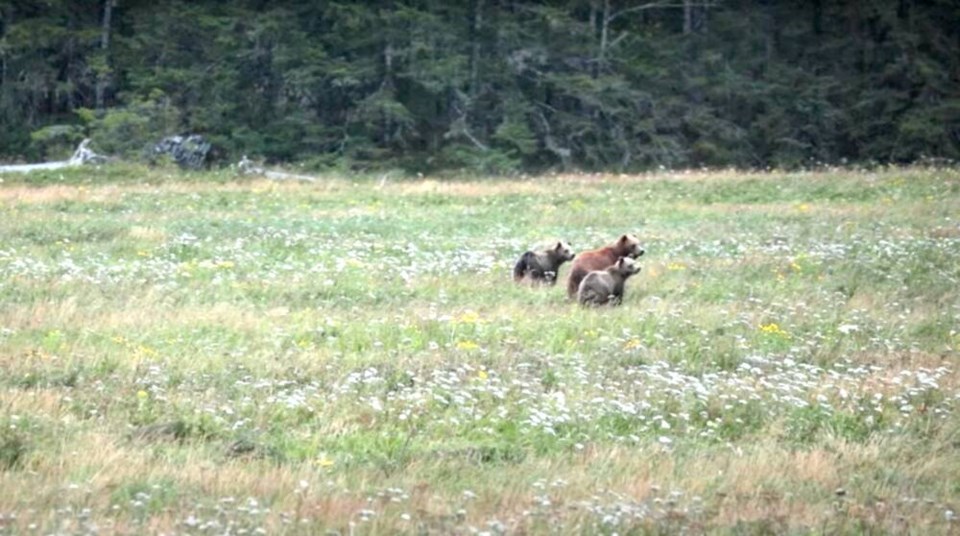The appearance of a mother grizzly bear and two young cubs near the village of Sayward is a sign that the big bears are going to establish a population on Vancouver Island, says a former guide and director of the Strathcona Regional District.
Gerald Whalley, who lives on the Salmon River, has been watching grizzlies swim over from the Mainland for a decade, but the dozens that have made the Johnstone Strait crossing by island-hopping to the narrowest point near Sayward have all been males.
But those grizzlies have always left, unable to find mates.
“I think this makes it a little more permanent,” said Whalley, who has been spotting the young family in the Salmon River estuary and area since June.
“It won’t be long before a boar shows up.”
Catherine Babault, a professional wildlife photographer based in Courtenay, captured video of the mother grizzly and two young cubs grazing in a meadow with a small herd of Roosevelt elk. The elk cows with calves moved toward the grizzly family, protecting their young, and the bears ran away, she said.
She did not divulge the location, fearing potential poachers and a flood of curious onlookers who may be at risk because the bear will aggressively protect her young.
Whalley believes the yearling cubs were born on Vancouver Island as the swim would have been too difficult for the young bears.
He said the tidal currents in Johnstone Strait between Vancouver Island and Hardwicke Island, the closest to Sayward, are “very strong.
“I was just out fishing the ebb tide and it gets rough out there,” said Whalley, adding that while grizzlies are powerful swimmers, he doesn’t think the cubs would make it or a mother bear would attempt the crossing with them.
The crossings in Johnstone Strait between Vancouver Island and the Mainland range from three to 4.5 kilometres
Garth Mowatt, a carnivore specialist with the Ministry of Water, Land and Resource Stewardship, told CHEK News it would be unlikely for the female bear to swim across with her young, but he didn’t rule out that the family made the swim more recently.
The ministry said Friday in a statement it believes the cubs are yearlings born in 2023, but was uncertain of their birthplace.
Whalley, the representative of Kyuquot, Nootka and Sayward on the Strathcona Regional District board, said island-hopping from the Mainland allows grizzlies to find new food sources such as fish and berries as well as elk and deer.
He said a ban on trophy hunting in British Columbia is likely the reason for a population explosion on the Mainland that is forcing younger bears out of traditional territories in search of food. Only First Nations are allowed to hunt grizzlies.
With pink salmon now massing in the Salmon River estuary and ready to move up to spawn, Whalley expects the bears to start moving up the river to more accessible fishing spots.
“It’s too deep in the estuary now for them to get any fish,” he said. In the meantime, Whalley said bears will be eating plants and berries, shellfish and crabs.
Babault said wildlife on the Island such as black bear and elk, will have to adapt if the grizzlies start repopulating the Island.
Based on current research, grizzly bears were known to be fully established on the Island during the last ice age, according to a statement from the province.
The ministry said grizzly bears are likely to compete with black bears for food and territory.
Babaut said people will have to act with caution. “People are used to seeing black bears, but we have to learn what to do when we see a grizzly,” she said.
Whalley said humans are typically in great danger when they get between a grizzly and its cubs or a food source.



